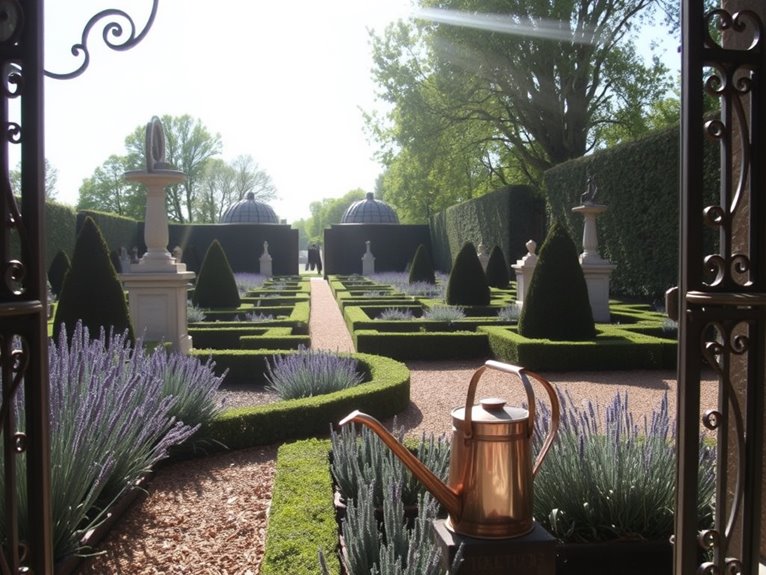
6 Unique Parisian Gardens With Historical Significance
Let me take you on a tour of Paris's six most extraordinary historical gardens! From the medieval medicinal herbs at Jardin des Plantes to the revolutionary secrets of Parc Monceau, each garden tells a unique story. I love how the Albert Kahn Gardens blend global styles, while Jardin Saint-Gervais preserves its 13th-century monastic design. Don't miss the royal splendor of Jardin de Bagatelle or the scientific wonders at Jardin du Roi. These green treasures hold centuries of fascinating tales within their walls.
The Medieval Herbs of Jardin Des Plantes
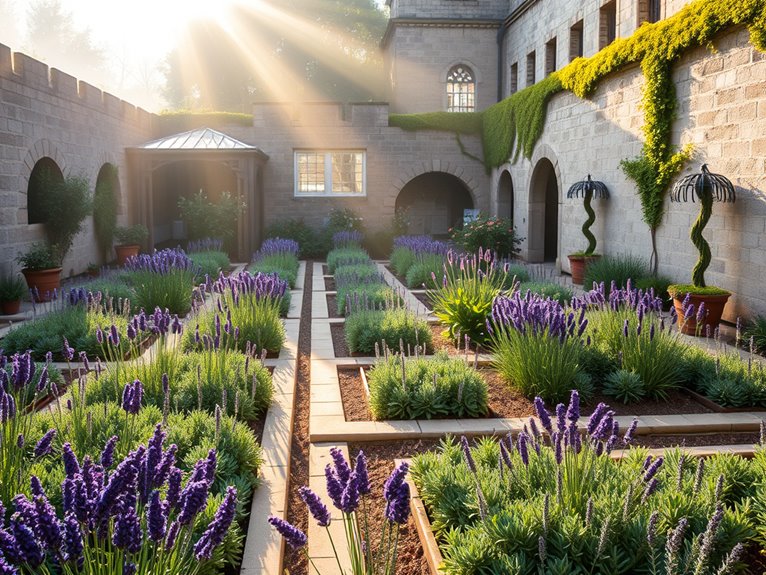
The Medieval Herb Garden at Paris's Jardin des Plantes stands as a living indication to centuries of botanical history, offering visitors a fascinating glimpse into the medicinal and culinary practices of medieval France. This meticulously maintained garden showcases over 50 varieties of herbs that were vital to daily life during the Middle Ages, from common cooking herbs to rare medicinal plants once used by monastery healers.
Established in the 17th century as part of the Royal Garden of Medicinal Plants, this section of the Jardin des Plantes maintains historical accuracy while educating modern visitors about the rich heritage of herbal medicine and medieval gardening techniques. The garden's careful organization reflects medieval design principles, with plants arranged according to their traditional uses and symbolic meanings.
Quick Facts:
- Best visiting hours: 8:00 AM – 6:00 PM (summer), 8:00 AM – 5:00 PM (winter)
- Admission: Free to the gardens
- Peak blooming season: May through September
- Photography allowed: Yes, without tripods
- Guided tours: Available Wednesday and Saturday mornings
- Accessibility: Wheelchair-friendly paths
- Language tours: French and English
Notable Medieval Herbs:
Sage (Salvia officinalis)
A cornerstone of medieval medicine, sage occupies a prominent position in the garden's central beds. Known as "sage the savior," this herb was believed to cure everything from snake bites to memory loss. The garden's specimens are particularly robust, benefiting from traditional cultivation methods passed down through generations.
Lavender (Lavandula angustifolia)
The medieval lavender plot demonstrates how monks used this versatile herb for both medicinal and practical purposes. Growing in neat rows along the southern exposure, these plants create stunning photo opportunities during June and July blooming seasons. Insider tip: Visit early morning for the strongest fragrance and best photography lighting.
Rosemary (Rosmarinus officinalis)
Located in the memory garden section, rosemary played a significant role in medieval funeral rites and memory enhancement practices. The garden's specimens are pruned in the traditional medieval style, forming intricate patterns that demonstrate period-accurate topiary techniques.
Pro Tips:
The best time to experience the Medieval Herb Garden is during the early morning hours when the essential oils in the plants are most concentrated. Consider bringing a sketchbook or notebook to document the plants and their uses, as many varieties feature informative plaques in both French and English. The garden curator often works Tuesday mornings, providing an excellent opportunity for impromptu discussions about medieval herbalism.
Practical Advice:
When visiting the Medieval Herb Garden, wear comfortable shoes suitable for gravel paths, and bring water, as the garden has limited shade. Photography enthusiasts should note that morning light provides the best conditions for capturing the herbs' detailed textures and colors. While touching plants is generally discouraged, scheduled sensory tours allow visitors to experience the herbs' fragrances and textures under expert guidance.
Hidden Revolutionary Tales at Parc Monceau
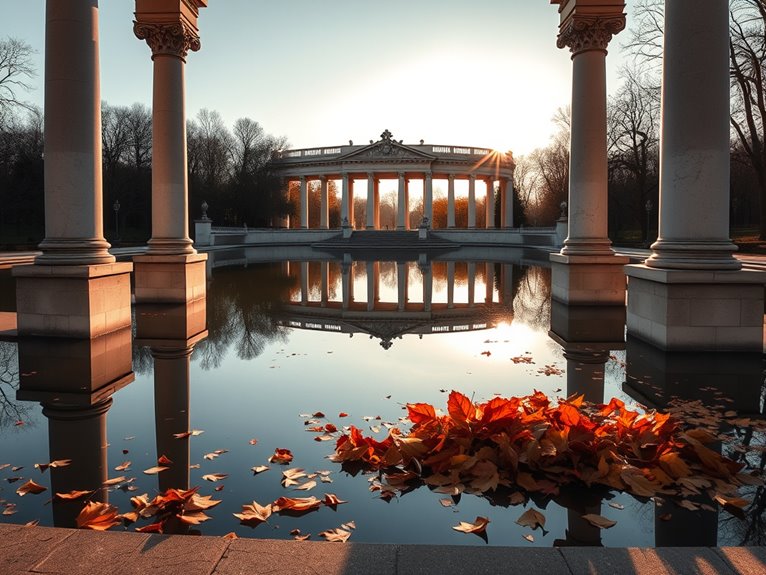
Nestled in the 8th arrondissement of Paris, Parc Monceau harbors secrets of the French Revolution beneath its manicured lawns and elegant pathways. This 17-acre garden, established in 1778, witnessed dramatic scenes during the revolutionary period, from clandestine meetings of resistance fighters to the execution of prominent aristocrats.
The park's revolutionary heritage remains visible in subtle details throughout the grounds, from the preserved classical colonnade to hidden symbols carved into ancient stones. While most visitors admire the park's romantic landscape and architectural follies, few realize they're walking through spaces where revolutionary history unfolded, making this guide essential for those seeking to uncover these compelling stories.
Quick Facts:
- Opening hours: 7am-10pm (summer), 7am-8pm (winter)
- Admission: Free
- Best visiting time: Early morning or late afternoon
- Photography: Golden hour provides perfect lighting for the classical structures
- Guided historical tours: Available first Saturday monthly
- Accessibility: Fully wheelchair accessible
- Nearest Metro: Monceau (Line 2)
Revolutionary Sites within the Park:
The Rotunda
Once a customs barrier where revolutionary guards monitored citizens entering Paris, this classical structure stands as the park's most prominent revolutionary landmark. Located at the main entrance on Boulevard de Courcelles, the rotunda features original 18th-century stonework with subtle revolutionary symbols. Insider tip: Look for the barely visible "Liberty, Equality, Fraternity" inscription near the base.
The Hidden Bunker
Beneath the Egyptian pyramid lies a former revolutionary meeting spot, occasionally open for special tours. While the bunker itself is rarely accessible, the surrounding area contains markers indicating where resistance fighters gathered. Insider tip: Visit during annual Heritage Days (Journées du Patrimoine) for rare access to the underground chamber.
The Massacre Memorial
Near the central pond, a discrete plaque commemorates the site where several aristocrats met their fate during the Terror. The location is marked by a ring of cypress trees. Insider tip: Local historians sometimes conduct unofficial tours focusing on this area's dark history.
The Revolutionary Garden
The northwestern section features plants arranged as they were during the revolution, including "liberty trees" planted in 1789. The original layout remains largely unchanged. Insider tip: The garden keeper maintains a small collection of period gardening tools, viewable upon request.
Pro Tips:
To fully appreciate the revolutionary heritage, visit during early morning hours when the park is least crowded, allowing uninterrupted examination of historical details. Consider downloading the park's historical audio guide, available through the Paris municipal website, which includes detailed accounts of revolutionary events not covered in standard tourist materials.
Practical Advice:
Photography of revolutionary sites is permitted, but tripods require advance permission from park administration. Bring comfortable walking shoes as revolutionary trail covers uneven terrain. Consider visiting the nearby Musée Carnavalet beforehand for additional revolutionary context, and remember that some historical markers are subtle – a detailed park map from the information kiosk is essential for locating all revolutionary points of interest.
Royal Secrets of Albert Kahn Gardens
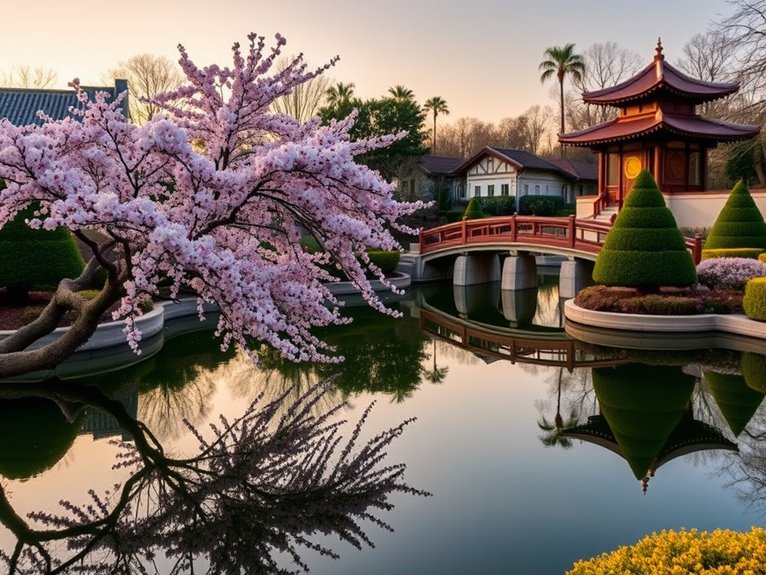
Hidden in the western suburbs of Paris, the Albert Kahn Gardens stand as one of the city's most remarkable yet lesser-known botanical treasures. Created by wealthy banker and philanthropist Albert Kahn in the early 20th century, these gardens represent his vision of promoting world peace through cultural understanding, manifested through a unique collection of garden styles from around the globe.
This four-hectare property showcases an extraordinary array of distinct garden environments, from traditional Japanese gardens to English cottages and French formal designs. Each space tells a story of Kahn's extensive world travels and his pioneering approach to cultural preservation, making it an essential destination for both garden enthusiasts and those seeking tranquil escape from urban Paris.
Quick Facts:
- Best visiting hours: 11 AM – 3 PM (fewer crowds)
- Admission: €4-8 (free first Sunday of each month)
- Photography permitted: Yes (tripods require permission)
- Seasonal highlights: Cherry blossoms (April), Autumn colors (October)
- Accessibility: Wheelchair accessible paths available
- Guided tours: Available in French and English (booking required)
Japanese Gardens
The crown jewel of the property features authentic Japanese landscape design with two distinct gardens: a contemporary garden and a traditional tea garden. Stone lanterns, carefully pruned bonsai trees, and a serene pond create an atmosphere of contemplation. The garden's moss collection is one of the largest in France, carefully maintained through traditional Japanese techniques. Insider tip: Visit during light rain when the moss gardens display their most vibrant colors.
English Garden
This romantic landscape showcases classic British horticultural design with winding paths, meadow flowers, and ancient trees. The garden includes a traditional cottage surrounded by climbing roses and seasonal blooms. Unlike most Parisian gardens, the English section is deliberately wild and naturalistic. Insider tip: Look for the hidden bench behind the large weeping willow – it's the best spot for bird watching.
French Garden
The formal French garden demonstrates classical symmetry and geometric precision. Immaculately maintained topiaries and perfectly aligned flowerbeds exemplify the French mastery of controlled nature. The space includes rare heritage rose varieties from Kahn's original collection. Insider tip: Visit at sunrise when the morning dew creates magical light effects on the geometric patterns.
Pro Tips:
The gardens are most magical during changing seasons – late spring and early autumn – when the vegetation shows dramatic color changes. Professional photographers should arrive at opening time for the best light conditions and minimal crowd interference. Consider visiting on weekday afternoons when local school groups have departed, allowing for a more peaceful experience.
Practical Advice:
Combine your visit with the adjacent Albert Kahn Museum, which houses his remarkable collection of early color photographs from around the world. Bring a light jacket even on warm days, as the Japanese garden areas can be noticeably cooler due to their dense vegetation and water features. The garden's location in Boulogne-Billancourt is easily accessible via Metro Line 10, but consider scheduling at least three hours for a complete exploration of all garden sections.
The Forgotten Monastery Gardens of Jardin Saint-Gervais
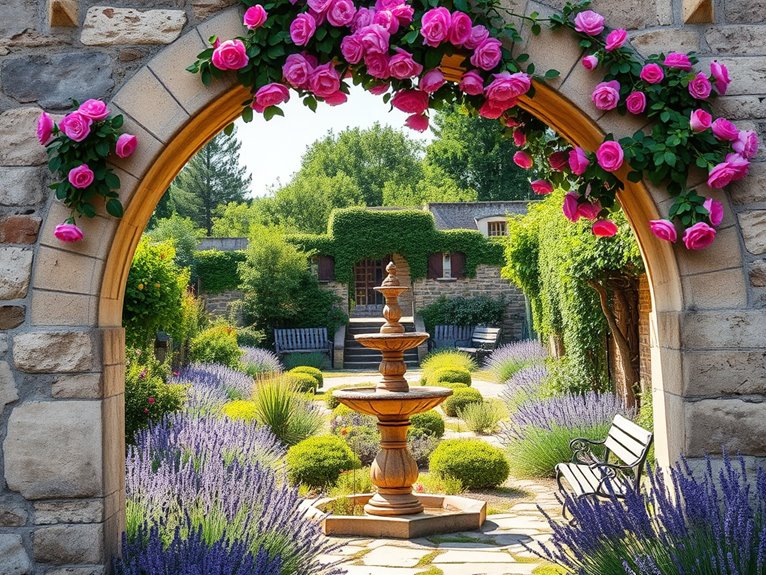
Nestled in Paris's 4th arrondissement, the Jardin Saint-Gervais stands as a hidden symbol of medieval monastic horticulture. These remarkably preserved gardens, dating back to the 13th century, offer visitors a rare glimpse into the contemplative world of monastery life while providing a peaceful refuge from the bustling streets of modern Paris.
Originally tended by Benedictine monks, these gardens once served both practical and spiritual purposes, growing medicinal herbs and providing space for meditation. Today, the restored gardens maintain their historical layout with four distinct sections: the herb garden (jardin des simples), the ornamental garden, the vegetable garden, and the meditation courtyard, each offering unique insights into medieval gardening practices and monastic life.
Quick Facts:
- Best visiting hours: 9:00 AM – 6:00 PM (April-October), 9:00 AM – 4:30 PM (November-March)
- Admission: Free
- Photography: Allowed, tripods permitted before 10:00 AM
- Guided tours: Available first Saturday of each month
- Accessibility: Wheelchair accessible paths
- Best season: Spring (April-May) for herb garden blooms
- Duration: 45-90 minutes recommended
The Herb Garden (Jardin des Simples)
This meticulously maintained section features over 40 species of medicinal herbs arranged in traditional raised beds. Medieval varieties like feverfew, sage, and angelica demonstrate the monastery's role in early medicine. Located in the eastern section, it's best visited in morning light. Insider tip: Touch the brass information plates to release herbal scents from embedded essential oils.
The Ornamental Garden
Featuring geometric patterns typical of medieval design, this garden showcases period-appropriate flowers and shrubs. Highlights include authentic rose varieties and topiaries shaped using medieval techniques. The central fountain dates to 1456. Insider tip: Look for the hidden mason's marks on the fountain's base, revealing its original craftsmen.
The Vegetable Garden
Demonstrating medieval crop rotation methods, this working garden grows historically accurate varieties of vegetables and fruits. Monthly harvests supply local food banks, continuing the monastery's charitable tradition. Insider tip: Check the garden shed's exterior for the monthly planting calendar, written in traditional calligraphy.
The Meditation Courtyard
The most serene area features original stone benches and a restored central well. Classical medicinal plants line the walls, creating a microclimate that maintains year-round greenery. Insider tip: Visit during the last hour before closing for near-complete solitude.
Pro Tips:
The gardens are most atmospheric during early morning hours when the herb garden's fragrances are strongest and photography conditions are ideal. Visit on weekdays to avoid weekend crowds, and bring a small notebook to record plant names and medieval gardening techniques. The best photos can be taken from the elevated walkway near the herb garden, particularly during golden hour.
Practical Advice:
Wear comfortable shoes with good grip, as the authentic medieval pathways can be uneven. The gardens lack modern amenities, so bring water and sun protection. While most areas are accessible year-round, some sections close for maintenance during January. Photography is permitted, but flash photography is prohibited in the meditation courtyard to maintain the contemplative atmosphere. Consider downloading the garden's free audio guide app before visiting, as Wi-Fi is not available on-site.
Aristocratic Heritage at Jardin De Bagatelle
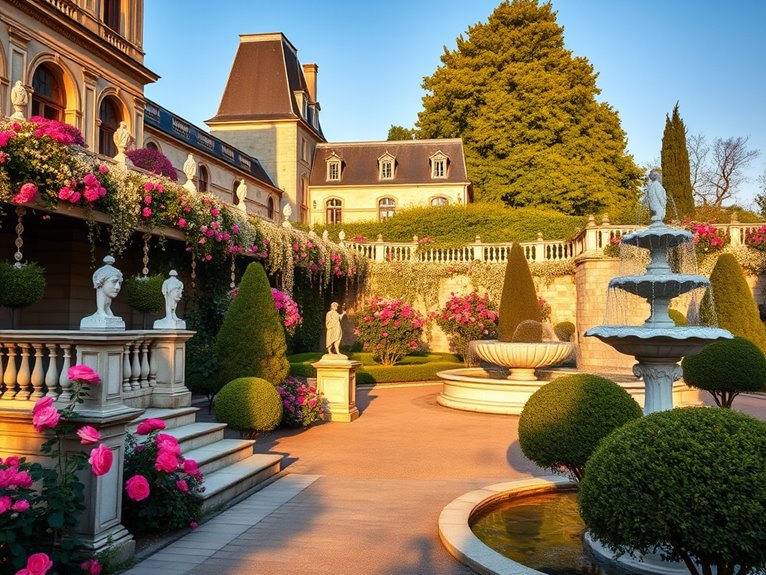
The Aristocratic Heritage at Jardin de Bagatelle stands as one of Paris's most enchanting historical gardens, created in 1775 as the result of a wager between Queen Marie-Antoinette and her brother-in-law, the Comte d'Artois. This elegant estate, nestled in the Bois de Boulogne, represents the pinnacle of 18th-century French garden design, combining formal landscaping with romantic elements that would later influence garden aesthetics throughout Europe.
Visitors today can experience the same aristocratic splendor that once captivated French nobility, from the meticulously maintained rose garden featuring over 10,000 roses to the neoclassical château that anchors the grounds. The garden's 59 acres offer a remarkable journey through time, showcasing both historical preservation and horticultural innovation that continues to evolve with each passing season.
Quick Facts:
- Best visiting hours: 9:30 AM – 7:00 PM (April to September), 9:30 AM – 5:00 PM (October to March)
- Entry fee: €2.50 for garden access, additional €2 for château visits
- Peak blooming season: May to September for roses
- Photography permitted: Yes, including tripods outside of peak hours
- Guided tours: Available on Saturdays and Sundays (reservation required)
- Accessibility: Most paths wheelchair accessible
- Restaurant: On-site orangerie café open April-October
Notable Features:
The Rose Garden
The internationally renowned rose garden houses one of Europe's finest collections, featuring both historic and modern varieties. Located in the garden's southern section, it hosts the prestigious International Rose Competition annually in June. Insider tip: Visit during early morning hours in mid-June for the best photography opportunities and to catch the roses at their most fragrant.
The Château
This small but exquisite neoclassical palace showcases period furniture and decorative arts. The upper floor offers stunning views of the formal gardens. Insider tip: The château's lesser-known basement level contains fascinating architectural models of the estate's historical evolution.
The Orangerie
Currently housing a charming café, this historic greenhouse structure maintains its original 18th-century features while serving as a peaceful retreat. Insider tip: Request a table in the eastern corner for the best garden views while dining.
The Water Features
A network of streams, ponds, and waterfalls creates a romantic atmosphere throughout the grounds. The grand cascade near the château provides excellent photo opportunities. Insider tip: The hidden grotto behind the main waterfall offers a unique perspective rarely discovered by tourists.
Pro Tips:
Plan visits for Tuesday or Thursday mornings to avoid weekend crowds and tour groups. The garden's micro-climate means flowers often bloom earlier than elsewhere in Paris, making April and early May ideal for viewing spring bulbs before the summer rose season begins. Consider purchasing an annual pass if staying in Paris for an extended period, as it provides unlimited access and special event invitations.
Practical Advice:
The garden's location in the Bois de Boulogne means it's slightly removed from central Paris. Take Metro Line 1 to Porte Maillot, then Bus 244 to the garden entrance. Wear comfortable walking shoes, as the grounds are extensive. Bring a water bottle and light snacks, especially if visiting during summer months when café lines can be long. Photography enthusiasts should note that tripod use is restricted during peak hours (11 AM – 4 PM) to prevent pathway congestion.
The Scientific Legacy of Jardin Du Roi
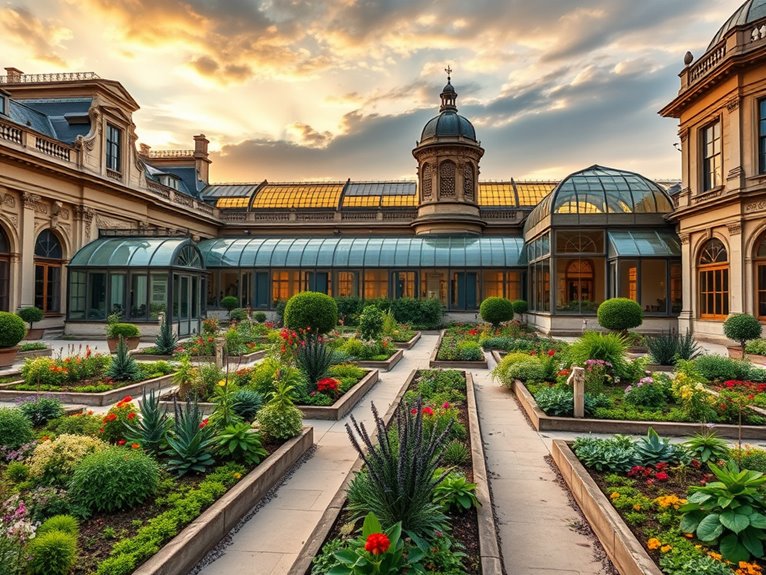
The Jardin du Roi, now known as the Jardin des Plantes, stands as one of history's most influential scientific gardens, fundamentally shaping modern botany and natural history. Established in 1635 as a royal medicinal garden, it evolved into a paramount center for scientific research and discovery, laying the groundwork for systematic botany classification and the development of modern natural sciences.
This historic garden not only served as the foundation for France's scientific revolution but also became the prototype for botanical gardens worldwide. Through its walls passed some of history's most renowned naturalists, including Georges-Louis Leclerc, Comte de Buffon, and Jean-Baptiste Lamarck, whose work within these grounds revolutionized our understanding of natural history and evolution.
Quick Facts:
- Opening Hours: 7:30 AM – 8:00 PM (summer), 7:30 AM – 5:30 PM (winter)
- Entry Cost: Gardens free; Museum admission €10
- Best Visiting Time: Spring and early summer for ideal botanical displays
- Photography: Allowed throughout gardens, permits required for professional shoots
- Guided Tours: Available in French and English, booking required
- Accessibility: Wheelchair accessible paths throughout main gardens
The Systematic Garden Collection
The heart of the scientific legacy lies in the systematic garden, featuring over 4,500 plant species arranged according to botanical classification. This living laboratory continues the garden's original mission of botanical research and education. The collection includes rare medicinal plants and specimens dating back to the 17th century.
The Grande Galerie de l'Évolution
Housed within the garden complex, this magnificent building showcases the garden's contribution to evolutionary theory. The gallery contains specimens collected during the garden's golden age, including contributions from expeditions sponsored by the royal garden. The building itself represents a masterpiece of 19th-century architecture.
The Historic Greenhouse Complex
Built in 1714, these greenhouses represent some of the oldest surviving scientific cultivation spaces in Europe. They house tropical and subtropical collections, maintaining the garden's tradition of exotic plant research and preservation. Special viewing hours allow visitors to explore these usually restricted areas.
Pro Tips:
For the most enriching experience, visit during weekday mornings when resident botanists often conduct their research. The garden's scientific significance is best appreciated through the guided "History of Science" tour, offered on the first Wednesday of each month. Photography enthusiasts should note that early morning light creates stunning opportunities in the systematic garden, particularly around the historic specimens.
Practical Advice:
While the garden welcomes casual visitors, serious researchers can arrange special access to the scientific collections through the garden's administration office. Bring a detailed map, as the scientific sections are spread throughout the complex, and consider downloading the garden's botanical app, which provides in-depth information about significant specimens and their historical importance.
